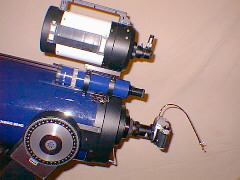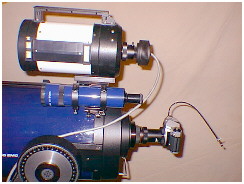GUIDING
Guiding is required for long deep space and short duration high magnification astrophotography. Most commercial telescopes are excellent for tracking while doing visual observing but small drive imperfections can cause stars to be egg shaped, or look like wavy lines, and photos to be blurry.
There are basically two methods to guide the telescope, one is to manually guide the telescope with the hand controller and the second is the use of an electronic auto-guider.
Manual Guiding
 For manual guiding, the use of an offaxis guider is recommended (see above image). An off axis guider fits between the telescope and the camera.. A 9mm or 12mm illuminated reticle is inserted in the off axis body. The operator then finds a bright enough star close to the object, centers it in the cross hairs/bullseye and keeps the star centered using the hand controller during photo aquisition. Finding a guide star while keeping the object to be photograped centered in the imaging telescope can be challenging.
For manual guiding, the use of an offaxis guider is recommended (see above image). An off axis guider fits between the telescope and the camera.. A 9mm or 12mm illuminated reticle is inserted in the off axis body. The operator then finds a bright enough star close to the object, centers it in the cross hairs/bullseye and keeps the star centered using the hand controller during photo aquisition. Finding a guide star while keeping the object to be photograped centered in the imaging telescope can be challenging.
 Another method of manual guiding is to use a guide scope mounted on the imaging telescope. No off axis guider is required. An illuminated reticle is placed in the eyepiece holder of the guide scope and guided by the hand controller. This method allows the finding of a guide star a little easier as the guide scope can be adjusted to find a star close to the object without moving the imaging telescope. The guide scope must be secured so as not to move (flex) during the guiding process. It is recommended that the guiding telescope be at least 1/3 the focal length of the telescope that is taking the photo.
Another method of manual guiding is to use a guide scope mounted on the imaging telescope. No off axis guider is required. An illuminated reticle is placed in the eyepiece holder of the guide scope and guided by the hand controller. This method allows the finding of a guide star a little easier as the guide scope can be adjusted to find a star close to the object without moving the imaging telescope. The guide scope must be secured so as not to move (flex) during the guiding process. It is recommended that the guiding telescope be at least 1/3 the focal length of the telescope that is taking the photo.
Electronic Guiding
 Electronic guiding uses a CCD (charged coupled device) to guide the telescope such as the SBIG ST4 Imager/Tracker shown. This device tracks a star electronically and pulses the telescope with extreme accuracy producing sharp images and pinpoint stars. This is a stand alone guider and does not require a computer, however, coupled to a computer it can be used as an imaging camera. The CCD imager/tracker is very sensitive and can guide on very faint stars that could not otherwise be guided visually.
Electronic guiding uses a CCD (charged coupled device) to guide the telescope such as the SBIG ST4 Imager/Tracker shown. This device tracks a star electronically and pulses the telescope with extreme accuracy producing sharp images and pinpoint stars. This is a stand alone guider and does not require a computer, however, coupled to a computer it can be used as an imaging camera. The CCD imager/tracker is very sensitive and can guide on very faint stars that could not otherwise be guided visually.
 The auto-guider can be used with either an off axis guider or with a guide scope as shown above.
The auto-guider can be used with either an off axis guider or with a guide scope as shown above.
Back
 For manual guiding, the use of an offaxis guider is recommended (see above image). An off axis guider fits between the telescope and the camera.. A 9mm or 12mm illuminated reticle is inserted in the off axis body. The operator then finds a bright enough star close to the object, centers it in the cross hairs/bullseye and keeps the star centered using the hand controller during photo aquisition. Finding a guide star while keeping the object to be photograped centered in the imaging telescope can be challenging.
For manual guiding, the use of an offaxis guider is recommended (see above image). An off axis guider fits between the telescope and the camera.. A 9mm or 12mm illuminated reticle is inserted in the off axis body. The operator then finds a bright enough star close to the object, centers it in the cross hairs/bullseye and keeps the star centered using the hand controller during photo aquisition. Finding a guide star while keeping the object to be photograped centered in the imaging telescope can be challenging. Another method of manual guiding is to use a guide scope mounted on the imaging telescope. No off axis guider is required. An illuminated reticle is placed in the eyepiece holder of the guide scope and guided by the hand controller. This method allows the finding of a guide star a little easier as the guide scope can be adjusted to find a star close to the object without moving the imaging telescope. The guide scope must be secured so as not to move (flex) during the guiding process. It is recommended that the guiding telescope be at least 1/3 the focal length of the telescope that is taking the photo.
Another method of manual guiding is to use a guide scope mounted on the imaging telescope. No off axis guider is required. An illuminated reticle is placed in the eyepiece holder of the guide scope and guided by the hand controller. This method allows the finding of a guide star a little easier as the guide scope can be adjusted to find a star close to the object without moving the imaging telescope. The guide scope must be secured so as not to move (flex) during the guiding process. It is recommended that the guiding telescope be at least 1/3 the focal length of the telescope that is taking the photo. Electronic guiding uses a CCD (charged coupled device) to guide the telescope such as the SBIG ST4 Imager/Tracker shown. This device tracks a star electronically and pulses the telescope with extreme accuracy producing sharp images and pinpoint stars. This is a stand alone guider and does not require a computer, however, coupled to a computer it can be used as an imaging camera. The CCD imager/tracker is very sensitive and can guide on very faint stars that could not otherwise be guided visually.
Electronic guiding uses a CCD (charged coupled device) to guide the telescope such as the SBIG ST4 Imager/Tracker shown. This device tracks a star electronically and pulses the telescope with extreme accuracy producing sharp images and pinpoint stars. This is a stand alone guider and does not require a computer, however, coupled to a computer it can be used as an imaging camera. The CCD imager/tracker is very sensitive and can guide on very faint stars that could not otherwise be guided visually. The auto-guider can be used with either an off axis guider or with a guide scope as shown above.
The auto-guider can be used with either an off axis guider or with a guide scope as shown above.